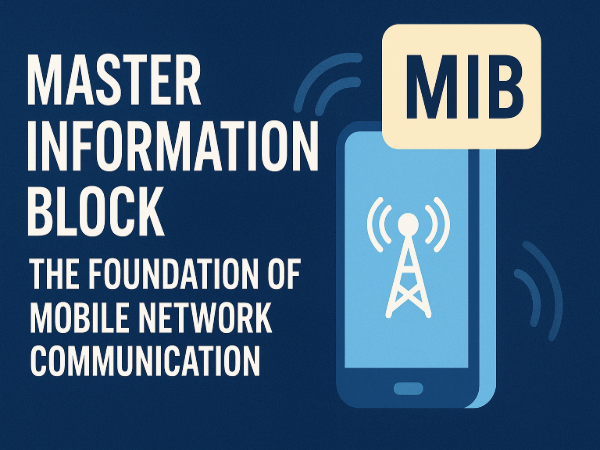Master Information Block: The Foundation of Mobile Network Communication
Understanding How the MIB Powers LTE and 5G Connectivity

The Master Information Block (MIB) is the cornerstone of mobile communication systems like LTE and 5G. It contains the essential system parameters that every mobile device (user equipment, or UE) must decode before accessing the network. The MIB provides crucial details such as cell bandwidth, frame number, and configuration data that enable devices to synchronize with a base station. Without the MIB, a device would not know how to locate or decode further system information. In both LTE and 5G NR, the MIB is transmitted over the Physical Broadcast Channel (PBCH), ensuring that every device entering the network area can quickly receive it.
Introduction to the Master Information Block
In mobile networks, communication between the base station and the user equipment begins with a series of systematic exchanges. Before a smartphone or IoT device can send or receive data, it must first understand the basic structure of the cell it’s trying to connect to. This is where the Master Information Block (MIB) plays a crucial role.
The MIB is a small but powerful message broadcast periodically by every cell tower. It carries minimal yet vital information that enables devices to synchronize their timing, identify system configurations, and prepare for further decoding of additional data known as System Information Blocks (SIBs). Essentially, the MIB acts as a network handshake—a device cannot move forward without it.
The Role of the Master Information Block in LTE and 5G
The MIB serves as the entry point for all mobile communication processes. In LTE (Long-Term Evolution) and 5G NR (New Radio) networks, it defines the primary setup information required for a device to begin communicating with the network infrastructure.
In LTE, the MIB contains details like the downlink system bandwidth, the PHICH (Physical Hybrid ARQ Indicator Channel) configuration, and a portion of the System Frame Number (SFN). These parameters help the user equipment establish time synchronization and locate the next level of system information.
In 5G NR, the MIB has been updated to include parameters like subcarrier spacing, SSB (Synchronization Signal Block) offset, and cell barring status. This additional data is necessary because 5G networks operate on a much wider range of frequencies and use flexible frame structures compared to LTE.
Where and How the MIB is Transmitted
The Physical Broadcast Channel (PBCH) is the key physical channel responsible for transmitting the MIB. This channel carries system information that all user equipment must read when accessing the network. The PBCH transmits only the Master Information Block, which is repeatedly broadcast at fixed intervals for reliability.
In LTE, the MIB is sent every 40 milliseconds, with redundancy built in so that devices can receive it even in poor signal conditions. It occupies a specific part of the spectrum centered around the DC subcarrier. This ensures that no matter the system bandwidth, the MIB can always be found in a predictable location.
In 5G, the MIB is transmitted within the Synchronization Signal/PBCH Block (SSB). The SSB structure helps devices identify synchronization signals first, then decode the MIB to gain essential parameters for further communication.
Decoding the MIB: Step-by-Step Process
Cell Search and Synchronization: The user equipment starts by scanning available frequencies for synchronization signals. These are the Primary Synchronization Signal (PSS) and Secondary Synchronization Signal (SSS). Once these are found, the device aligns its frequency and time references with the network.
PBCH Detection: After synchronization, the device identifies and decodes the PBCH, which carries the MIB. This step is critical because the PBCH is the gateway to all other system information.
MIB Extraction: The device decodes the MIB content to learn about system bandwidth, frame number, and other configurations.
SIB Acquisition: With the MIB decoded, the device can now locate and decode System Information Block Type 1 (SIB1), which provides more detailed network configuration parameters.
Network Access: Once the MIB and SIBs are decoded, the device can proceed with the Random Access Procedure, initiating connection setup with the base station.
Key Elements Contained in the MIB
Although the MIB is small—just a few bits of information—it carries essential data that allows the network connection to function properly. Here’s what it typically contains:
For LTE:
-
Downlink Bandwidth: Indicates how many resource blocks are available for downlink communication.
-
PHICH Configuration: Defines the structure for acknowledgment channels used in hybrid ARQ processes.
-
System Frame Number (SFN): Provides timing information that helps devices synchronize with the network.
For 5G NR:
-
Subcarrier Spacing: Defines the distance between subcarriers, crucial for understanding 5G’s scalable frame structure.
-
SSB Subcarrier Offset: Helps the UE identify the correct position of synchronization blocks.
-
Cell Barring Information: Indicates whether a particular cell is available for connection.
-
DMRS Type Position: Specifies reference signal positions for demodulation purposes.
Importance of the Master Information Block
The MIB is not just a technical requirement—it’s a fundamental enabler of connectivity. Every time you turn on your phone, your device depends on the MIB to identify and connect to a cell.
Without it:
-
The device would not know the cell’s bandwidth or structure.
-
It couldn’t synchronize with the network.
-
Further system information could not be decoded.
This is why the MIB is always transmitted at high priority and with high reliability. It ensures that devices in any signal condition—urban, rural, or indoor—can receive the data they need to start communicating.
Master Information Block vs. System Information Block
It’s important to distinguish between MIB and SIB (System Information Blocks).
-
The MIB is the first block that every device must decode. It contains the most basic and universal parameters.
-
SIBs follow after the MIB and provide more specific configurations such as cell identity, scheduling, mobility parameters, and network access restrictions.
You can think of the MIB as the “entry key” that unlocks the door to the rest of the network information provided by the SIBs.
Transmission Characteristics of the MIB
The MIB is designed for reliability and consistency. In LTE, it is repeated across multiple radio frames to ensure that all devices—regardless of location or movement—can receive it.
Key characteristics include:
-
Transmission Interval: Every 40 ms in LTE.
-
Modulation Scheme: QPSK (Quadrature Phase Shift Keying).
-
Mapping: Fixed location within the central subcarriers.
-
Redundancy: Repeated in multiple frames for robustness.
In 5G, the transmission approach is similar, but the periodicity can differ due to the flexible numerology and the use of SSBs.
Why the MIB Matters in Network Engineering
For network engineers, understanding the MIB is essential for effective cell planning, network optimization, and device testing.
-
Cell Planning: Engineers must configure MIB parameters correctly to ensure that all devices can discover and synchronize with the network.
-
Network Optimization: By analyzing MIB broadcasts, engineers can identify configuration mismatches, coverage gaps, or transmission issues.
-
Device Testing: When testing new devices, decoding the MIB confirms whether the device can properly detect and align with network parameters.
Master Information Block in Real-World Scenarios
In practice, the MIB plays a crucial role in many everyday and industrial applications.
-
Smartphones: When you switch on your mobile device, the MIB is one of the first signals decoded to establish network presence.
-
IoT Devices: In low-power networks, IoT modules rely on MIB to determine network timing and bandwidth.
-
Vehicle Connectivity: Connected vehicles use MIB data to maintain continuous communication during mobility handovers between cells.
-
5G Deployments: The MIB ensures smooth access in high-frequency bands (like mmWave), where synchronization is more challenging.
Differences Between LTE and 5G MIB
| Feature | LTE MIB | 5G NR MIB |
|---|---|---|
| Transmission Channel | PBCH | PBCH within SSB |
| Main Parameters | DL bandwidth, PHICH config, SFN | Subcarrier spacing, SSB offset, cell barring |
| Bandwidth | Fixed to 6 RBs | Variable depending on SSB |
| Transmission Interval | 40 ms | 80 ms (varies by configuration) |
| Purpose | Enables LTE network access | Enables 5G NR initial access |
Challenges Related to MIB Reception
While the MIB is designed for reliability, it’s not immune to challenges:
Poor Signal Conditions: Weak coverage areas may delay MIB decoding.
Interference: Overlapping cells can cause confusion in synchronization.
Incorrect Configuration: Network misconfiguration can lead to devices being unable to access the network.
Engineers often use field tools to measure MIB reception quality to maintain optimal network performance.
Conclusion
The Master Information Block (MIB) is the heartbeat of cellular connectivity. It’s small in size but carries monumental importance in enabling devices to connect, communicate, and synchronize with mobile networks. From LTE to 5G NR, the MIB ensures every user equipment—whether a smartphone, IoT sensor, or autonomous vehicle—can discover and engage with a network cell efficiently.
Understanding how the MIB works not only highlights the elegance of mobile network design but also underscores the precision required to maintain seamless connectivity worldwide. As networks evolve toward 6G, the principles behind the Master Information Block will continue to serve as a foundational framework for all forms of wireless communication.



